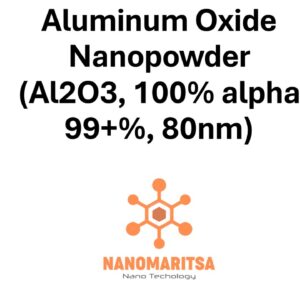Nickel oxide nanopowder (NiO, 99%, 10-20 nm) is a high-purity material with a unique set of physical and chemical properties. This nanopowder, composed of nickel and oxygen in the form of nickel(II) oxide, is used in a wide range of applications due to its distinct properties, such as its ability to act as a semiconductor, catalyst, and electrochemical material.
Composition and Structure
NiO (Nickel Oxide):
Nickel oxide is an inorganic compound composed of nickel and oxygen. In its nanopowder form, NiO exhibits enhanced surface area and reactivity compared to bulk nickel oxide. This allows for a range of advanced applications, particularly in the fields of catalysis, energy storage, and environmental remediation.
Purity (99%):
With a purity of 99%, this nickel oxide nanopowder is highly concentrated, containing minimal impurities that could interfere with its performance. High purity ensures that the material is effective and reliable in sensitive applications where consistency and high performance are required.
Particle Size (10-20 nm):
The 10-20 nm particle size contributes to the material’s increased surface area, which enhances its reactivity and makes it more effective in applications like catalysis, sensors, and electrochemical reactions. The small particle size also provides superior control over the material’s physical and chemical properties, which can be tuned for specific uses.
Properties
- High Surface Area and Reactivity:
Nickel oxide nanopowder has a significantly higher surface area compared to bulk NiO, which enhances its chemical reactivity. This increased reactivity is particularly useful in applications like catalysis, where surface interactions are key to achieving efficient reactions. - Electrical Properties:
NiO has semiconducting properties, and in nanopowder form, these properties are amplified. The material can be used in electronic devices, sensors, and energy storage systems, where its electrical conductivity can be optimized for specific needs. - Catalytic Activity:
Nickel oxide is known for its catalytic properties, particularly in reactions involving oxidation, hydrogenation, and energy conversion processes. The nanopowder form enhances these catalytic activities, making it more efficient in applications like fuel cells and pollution control. - Thermal Stability:
Nickel oxide nanopowder is stable at high temperatures, making it suitable for use in industrial processes and high-temperature environments. Its stability ensures that it performs reliably without degradation or loss of functionality. - Magnetic Properties:
While NiO itself is antiferromagnetic at room temperature, it can exhibit interesting magnetic behavior when used in nanoparticle form, which may have applications in various magnetic storage and sensing technologies.
Applications
1. Energy Storage and Batteries:
Supercapacitors and Batteries:
NiO nanopowder is used in the development of supercapacitors and lithium-ion batteries. Its high surface area and electrochemical properties allow for improved energy storage and charge/discharge cycles, enhancing the performance of energy storage devices.
Fuel Cells:
Nickel oxide is used as a catalyst in fuel cells, where it aids in the conversion of chemical energy into electrical energy. The nanopowder form of NiO provides a greater surface area for catalytic reactions, improving the efficiency of fuel cell processes.
2. Catalysis and Chemical Reactions:
Catalyst for Oxidation Reactions:
NiO nanopowder is used as a catalyst in various oxidation reactions, such as the oxidation of carbon monoxide in exhaust systems or the oxidation of hydrocarbons in industrial processes. Its high surface area increases the rate of reaction, making it an efficient catalyst.
Hydrogenation Reactions:
Nickel oxide is also employed in hydrogenation reactions, where it aids in the addition of hydrogen to organic compounds. Its ability to facilitate these reactions makes it useful in the production of chemicals, pharmaceuticals, and food processing.
3. Electronics and Sensors:
Electrochemical Sensors:
NiO nanopowder is used in the fabrication of electrochemical sensors, which can detect various gases or changes in chemical composition. Its semiconducting properties allow for the detection of specific target molecules, making it valuable in environmental monitoring and industrial safety applications.
Memory Devices and Capacitors:
Nickel oxide is used in memory devices and capacitors due to its ability to store electrical charge. The nanopowder form enhances its properties, allowing for more efficient storage and retrieval of data.
4. Environmental Applications:
Pollution Control:
NiO nanopowder is employed in environmental remediation, particularly in the removal of toxic gases and pollutants. Its catalytic properties enable it to break down harmful substances, making it useful in air purification systems and waste treatment.
Water Treatment:
Nickel oxide is also used in water treatment processes, where its high surface area allows for the adsorption and removal of heavy metals and other contaminants from water sources. This helps in improving water quality and reducing pollution.
5. Materials Science and Nanotechnology:
Nanocomposites and Coatings:
NiO nanopowder is incorporated into nanocomposites and coatings to enhance the mechanical, thermal, and electrical properties of the material. These composites are used in a variety of industries, including aerospace, automotive, and electronics, where advanced materials are required.
Magnetic Materials:
Although NiO is antiferromagnetic at room temperature, its nanoparticle form can exhibit unique magnetic behaviors. This makes it useful in applications requiring magnetic materials, such as in magnetic storage devices, sensors, and other specialized devices.
Safety and Handling
Health Considerations:
Nickel oxide is generally considered toxic if inhaled or ingested, and exposure to nickel-containing dust and fumes should be avoided. Proper protective measures, including respiratory protection, gloves, and eye protection, should be used when handling nickel oxide nanopowder.
Environmental Impact:
Nickel oxide nanopowder should be handled with care to prevent environmental contamination. Research into its environmental impact is ongoing, but it is important to follow safety guidelines for disposal to minimize any potential risks to ecosystems.
Summary
Nickel oxide nanopowder (NiO, 99%, 10-20 nm) is a highly versatile material with a broad range of applications, from energy storage and catalysis to environmental remediation and electronic devices. Its high surface area, catalytic properties, and semiconducting behavior make it valuable in various industries, including energy, electronics, materials science, and pollution control. The nanopowder form enhances its performance, making it an ideal material for use in advanced technologies that require efficient chemical reactions, energy conversion, and sensing capabilities.
| Measurement (gr) | 100 grams, 500 grams, 1000 grams |
|---|






